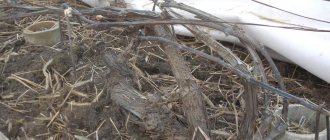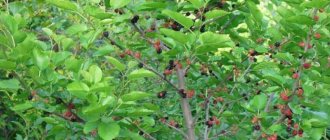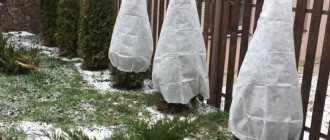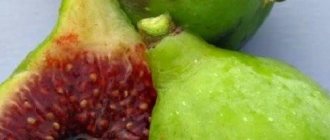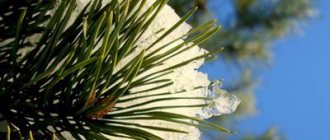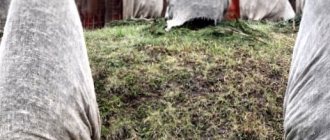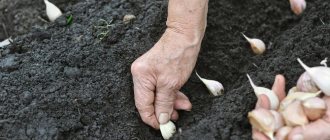Rhododendron or Azalea - a brief description of the flower
Rhododendron is a low shrub with dark bark, the branches of which reach a length of 2-4 meters. Young shoots are covered with glandular-descent scales, which disappear by the 4th year. The leaves are alternate, with petioles, entire, their length is 2 cm in a young plant and 8 cm in a mature shrub. The leaf has an elliptical shape, tapers towards the base, the edges roll down.
The decorative value of the plant lies in its flowering. The flowers have a long stalk and are collected at the end of the branch into a bouquet of 3-5 buds. The corolla is irregular, reaches 5 cm in diameter, light yellow with a wide funnel and 5 lobes. The flower has 10 stamens of different lengths. The plant reproduces by seeds, they are small and ripen at the end of August. Growing an adult bush from seeds under normal conditions is difficult. Azalea has a distinct, pleasant scent of green strawberries.
Garden azalea belongs to the Heather family. This genus is represented by shrubs and trees, deciduous, semi-deciduous and evergreen plants. The genus contains more than 1000 species.
Interesting to know! The name of the plant includes 2 words, rhodon translated from Latin means rose, and dendron means tree, which is why among gardeners Azalea is called a rose tree. In appearance, Rhododendron bears some resemblance to the rose, the queen of flowers.
In the wild, the plant is distributed in the following regions:
- Southeast Asia;
- Japan;
- America;
- Southern China;
- Himalayas.
Shrubs grow well near seas, oceans, and on mountain slopes. They prefer partial shade. Flowers of different species of this genus differ in color, but also in size and shape.
Reproduction
Only experienced gardeners should propagate rhododendrons. In the Moscow region it is better to do this in spring and late summer. The main method involves the use of cuttings obtained from the side shoots of an adult bush. Stems about 10-12 cm long must be cleared of lower leaves and buds, and their bark must be torn off in one place so that a 2-centimeter strip of “bare” trunk is formed.
Place such a branch in a pot of soil acidified with peat. Place the pots, covered with foil or a plastic lid, in a bright room with a temperature of about +21-23 degrees Celsius, but not in direct sunlight.
A condition for the successful development of planting material will be care for high humidity of the substrate and air around the plants.
How to properly prepare for winter
Flowering shrubs require care not only during the period of active growth and flowering, but also in the fall. The intensity of growth and the abundance of flowering of the plant in the next season depends on how rhododendron overwinters. First-year shrubs require careful care. If the plant is classified as evergreen, it requires year-round watering because their foliage evaporates moisture. Despite the fact that Azalea is a delicate flower, breeders have developed varieties that can successfully withstand temperatures down to -35 degrees.
Trimming
You should not ignore the need for regular, annual pruning of evergreen shrubs. Broken and frostbitten shoots must be removed. They do not easily spoil the appearance, but can become sources of pathogenic infection, causing damage to the plant and leading to its complete death.
With proper care, damage to shoots rarely occurs, but this is not a reason to postpone pruning. Anti-aging pruning guarantees lush flowering next year. It helps shape the crown of the bush. The procedure can be carried out in spring or autumn, the optimal period is determined depending on the variety.
There are 3 types of trimming:
- sanitary – carried out at any time of the year, rotten, damaged shoots are removed, included in the range of mandatory measures before wintering;
- forming - carried out in spring or autumn, shoots are pruned to form a uniform crown;
- rejuvenating - carried out once every 3 years, old shoots are removed to stimulate the growth of new ones; without such conditions, the shrub will not bloom.
Attention!
Pruning should not be done during the flowering period. A capricious plant may drop its buds. Above-ground parts affected by pests are removed regardless of season and flowering.
With sanitary pruning, only damaged branches are removed to healthy areas. In deciduous plants, the bark is damaged in winter, so it is also cut down to living tissue. Anti-aging pruning is a total pruning that involves removing 60% of the branches. The volume of shoots removed during shaping trimming varies at the discretion of the gardener. The manipulation is carried out with a sharpened pruner so as not to damage the bark.
Pruning in the fall is carried out 2 weeks before the expected onset of the first frost, therefore it is impossible to indicate its timing. Recommendations vary by region. In the Moscow region, Azaleas need to be pruned in early October. The cut areas must be treated.
Watering
Rhododendron is a moisture-loving plant that is sensitive to lack of moisture, especially at a young age. In the first year after planting, it is necessary to control soil moisture not only in summer, but also in winter. There is no need to flood the shrub; the humidity regime needs to be adjusted. Excess water will cause rotting of the fragile root system.
Attention is paid not only to the irrigation process, but also to the quality of the water used - it should be soft. Rainwater, melted water or collected from a clean pond are suitable. If autumn is dry, the bush is additionally sprayed. You can determine the lack of moisture by looking at the leaf; it becomes dull and droops. Brown spots appear on its edges, resembling a fungal infection. The basic rule of watering is regularly, but in small quantities.
Top dressing
To organize fertilizing in the autumn, mineral and organic fertilizers are used. Mineral ones include phosphorus and potassium, and organic ones include bone meal, manure, pine needles and peat. Experienced gardeners recommend mixing them. Since the root system of the plant is close to the soil, the feeding material must be dissolved in water before being applied to the soil.
Azalea loves acidic soil, so mineral components that meet this indicator are used for fertilizer. Superphosphate optimizes the formation of buds, magnesium sulfate compensates for the lack of microelements in the soil, and potassium sulfate accelerates the ripening of the bark on the shoots of the bush. It is forbidden to use fertilizers containing chlorine, they will destroy the azalea.
Rotted manure is used to improve soil fertility and increase moisture permeability. Bone meal helps to compensate for the lack of microelements in the soil and provides nutrition to the plant for a long time. Organic fertilizers do not have to be added to the soil with water; they can be scattered on the ground, around the trunk of the plant. Thus, they feed carefully, using a small amount of organic matter.
Attention!
When preparing for winter holidays, it is recommended to feed rhododendron with a mixture of peat and pine needles. This fertilizing will increase the acidity of the soil and will not harm the surface roots of the shrub.
In winter, the plant is not fed. The last feeding is carried out before the onset of frost. After freezing, the plant is watered if there is no snow cover. When the soil freezes, watering is canceled.
Treatment against diseases and pests
Often after overwintering, azaleas look unhealthy due to non-infectious lesions that appear due to winter drying out or soaking. It is also possible to show signs of infectious fungal infections.
Winter drying occurs after a long winter with severe and prolonged frosts. At the same time, rhodondendron leaves remain curled in the spring, despite positive temperatures. Such symptoms indicate that the leaves of the plant have lost all moisture in winter. The grower must restore water circulation in the soil. To do this, you need to water the plant and spray it 2 times a day after the soil has thawed. It is quite difficult to prevent the problem; proper covering helps to partially improve the prognosis.
On the contrary, excessive soil moisture leads to soaking. The leaf becomes gray-green, dull, and falls off for no apparent reason. Soaking often occurs if proper drainage is not provided and the soil is not mulched. The plant needs to be transplanted to a new location.
A seedling may die from fungal infections:
- Fusarium - damage to the roots occurs, the movement of nutrients through the vessels is disrupted. The leaves wither and turn brown, and plaque appears on the root collar. It is better to isolate the bush from other plants and treat it with Fundazol.
- Alternaria blight - red spots appear on the leaves. Brodsky acid is used for treatment.
- Phyllocystic disease - brown spots appear on the leaves, framed by a brown border. When affected, the middle of the leaf dries out and falls out. The affected parts are removed, and healthy areas are treated alternately with the working solution of Topsin and Fundazol.
- Cecrosporosis - brown spots appear on the back of the plate. The top of the leaf is covered with a gray coating. Fungicides are used for treatment.
Attention!
Fungal infections are the most common cause of death of young seedlings and adult plants. To prevent infection, the plant must be periodically treated with fungicides. Before sending it to rest, the bush is treated with a concentrated solution of Fundazol, after cutting off all affected leaves and shoots.
Azalea diseases are caused by various pests, but the gardener encounters them during the growing season. Before wintering, the bush should be carefully examined for the presence of aphid larvae, whiteflies, slugs and thrips. If there are signs of damage, it is necessary to treat with Actelik or Aktara.
Mulching
Azalea has a superficial root system, so freezing of the underground part is the most common cause of plant death in spring. The bush needs to be mulched before the onset of cold weather. For this, a mixture of pine needles and high-moor peat is used - this composition also provides nutrition in winter.
If the plant has a height of more than one meter, the mulch is laid out in a mound, the height of which reaches 30-35 cm. It is better to cover the entire area of the ground near the roots; ideally, the mulch is laid over the entire area of the ground under the bush.
Many gardeners make the common mistake of using fallen azalea leaves for mulching. This is strictly forbidden, because they can be sources of bacteria and fungi. It is impossible to review each sheet before use, so they must be thrown away.
Shelter
Rhododendron tolerates light frosts well. Therefore, it is necessary to cover it for the winter after the onset of stable cold weather - the average temperature per day should be at least - 10 degrees. Early covering will create conditions for the formation of condensation, leading to rotting of the root collar of the plant.
Frost-resistant, deciduous varieties tolerate severe frosts down to 35 degrees, so before wintering they are simply pruned, treated for diseases and the soil is mulched. Only young plants planted this year require shelter. For shelter, burlap or cardboard is used; the main condition when choosing a material is its breathability.
Non-frost-resistant varieties that overwinter green need to be covered even in regions with relatively high temperatures in winter. This rhododendron does not tolerate temperature drops of more than -10 degrees.
Advice from experienced gardeners
In order for pruning rhododendrons to give the desired result, it is useful to listen to the opinions of experienced gardeners who have been successfully growing this luxurious shrub for many years.
- After any pruning, even sanitary pruning, rhododendron bushes must be watered abundantly and fed with a comprehensive set of fertilizers. The only exception is autumn pruning.
- It is best to prune bushes regularly, ensuring the correct shape of the plants every year. If for some reason the rhododendron has not been pruned for a long time, then you should not carry out drastic pruning during one season. It's better to do this gradually.
- When formative and rejuvenating pruning in early spring, it is very important to feel for dormant buds and trim the branches above them. Dormant buds usually appear as small thickenings of a pinkish tint on the shoots and are quite easy to feel with your fingers.
- If rhododendrons were grown from seeds, they should not be pruned at all until the first flowering. Otherwise, it may delay the formation of flowers for another 2-3 years.
Care depending on region: table
The winter-hardy plant can be grown in all regions of Russia, but the principles of care may differ slightly. The table describes the main recommendations.
| Type of work | Regions of Russia | |||
| Middle lane | Leningrad region | Siberia | Ural | |
| Trimming | Can be carried out in autumn and spring. In autumn, it is carried out before frost sets in. | Conducted 2 weeks before expected frosts, in the spring - after stabilization of above-zero temperatures. | Exclusively in spring after complete removal of snow cover. | Only in the spring, pruning before wintering weakens the azalea, and it can die if the temperature drops significantly, regardless of the shelter. |
| Watering | Water before applying mineral fertilizers if autumn is not rainy. | Often watering is not required due to the high humidity in the region. | Until the air temperature drops. | Watering is not required in autumn and winter. |
| Top dressing | It is carried out 2 weeks before the onset of frost. | |||
| Pest treatment | After feeding. | |||
| Mulching the soil | Mulch is laid in a layer of up to 10-15 cm. | Mulch is laid when the temperature drops to -10 degrees in a layer of up to 20 cm. | The roots are covered with mulch as much as possible. The material is spread over the entire surface under the plant. The height of the embankment should be at least 25 cm for frost-resistant varieties and more than 35 for evergreens. | |
| Shelter | Deciduous varieties can overwinter without shelter; evergreen varieties require simple protection from the cold, for example, wrapping them in burlap or constructing primitive protective structures. | Frost-resistant varieties that shed leaves in the fall are wrapped in dense, breathable material. Evergreen varieties have difficulty withstanding winter in Siberia and the Urals, therefore it is recommended to use methods of maximum insulation. It is recommended to build a hut-type shelter using spruce branches. | ||
The rules of care during the growing season of rhodondendron do not change by region. The plant requires regular watering, additional spraying, fertilizing, and timely removal of faded buds.
Life cycle features
Depending on the variety, the plant can be:
- Deciduous. In the fall it loses all its leaves, and in the spring it grows its leaf mass again. It is frost-resistant and unpretentious.
- Semi-deciduous. Loses green mass once every 2 years.
- Evergreen. Does not shed leaves after the end of the growing season. The varieties are not frost-resistant. Therefore, they need to be carefully covered for the winter, even in the Moscow region.
Attention!
You need to select a suitable shrub for your own landscape depending on the region. For example, a semi-deciduous plant winters well in the middle zone, and an evergreen plant in the south of Russia. Deciduous plants can withstand significant frosts in Siberia and the Urals.
How to insulate each type of garden azalea
Azaleas are more sensitive to lack of moisture than to extreme cold, so it is important to protect the plant from dehydration. Basic recommendations for species common in Russia:
- Deciduous. The bush reaches a height of 1.5, therefore, before wrapping, the branches are bowed to the ground and sprinkled with leaf mixture or peat.
- Japanese rhodondendron. It is characterized by dwarfism, its height is up to 50 cm, so it is convenient to cover it with cardboard or burlap after the temperature drops to -10.
- Evergreen. Young bushes are covered with spruce branches even in the south of Russia. Mature shrubs tolerate cold temperatures well, so it is necessary to cover rhododendron for the winter in the Moscow region and the Urals.
- Multi-flowered azalea. The plant is not afraid of slight cooling. After the temperature drops to -10, a frame is built from boards and wrapped in breathable, non-woven material.
Gardeners recommend covering any type of azalea for the winter, because the plant can be severely damaged by wind rather than frost. A winter without snow is dangerous for her.
Store designs
If you don’t have the opportunity to build a shelter for a rose tree yourself or the opportunity doesn’t allow you, you can buy a ready-made one. Often such structures consist of a frame accompanied by a special covering material. The device is convenient to use - it is simply installed at the right time and removed in the spring, after the temperature has stabilized.
Self-created
To make the frame you will need the following tools:
- screwdriver;
- screws;
- hacksaw;
- jigsaw;
- saw.
Boards or timber are used for the frame; covering material is also required.
Construction instructions:
- The frame is made of boards or timber, fastened together in a wigwam format.
- The height must be calculated so that the structure is 20 cm higher than the branches.
- The material is pulled over the frame so that the cover lies on the ground.
- The cover is spread on the soil and applied with bricks.
Next way:
- A stool is made from wood and metal.
- The lid is made from sawdust pressed into timber.
- The structure is covered with litrasil, its edges are pulled to the ground.
The disadvantage of the design solution is that, in this way, only a short plant can be insulated.
The simplest method:
- Small holes are made in a thick cardboard box for ventilation.
- Install the structure on the bush and cover it with breathable material.
- The edges of the material are stretched along the ground.
The method is suitable for mature plants up to a meter in height.
Closing instructions
In general, the closing process includes:
- watering is stopped late in the fall, before frost sets in;
- fertilize rhododendron with a potassium- and magnesium-containing composition;
- carry out formative pruning;
- treated against fungus and pests;
- arrange mulching;
- if the bush is tall, its branches bend to the ground;
- cover according to the chosen method.
Wintering ends in early March, after the ambient temperature rises.
Attention!
After wintering, the plant needs to be accustomed to sunlight gradually, therefore, after removing the covering structure, the azalea is shaded.
Deadlines for when to carry out work
The optimal timing for creating a shelter and removing it, depending on the region, is described in the table:
| Process | Central Russia, Moscow region, Ukraine | Leningrad region | Siberia | Ural |
| Beginning of wintering | November | November | Late September – early October | End of october |
| Awakening | March | March | Mid April | Early April |
The given dates are approximate, that is, the gardener must clarify the weather forecaster’s forecast and take it into account. If, according to the forecast, the onset of winter is promised early, you need to have time to carry out all the work before this moment.
In autumn, shrubs should be wrapped in several stages:
- First you need to insulate the bushes from below. This can be done using peat. With the arrival of the first frosts, you need to build some kind of wire frame, on which insulation will be subsequently applied. Its edges are driven deeper into the ground until it freezes. The height of the arches should be made taking into account the height of the plant itself. The branches of the bush should not touch the shelter. A gap should be left between them. The arcs should not be located close to the bush (the free gap on all sides is better if it is 20-30 centimeters). The result will be a frame structure (like a dome) over the plant.
- With the arrival of the first persistent frosts, the rhododendron can be covered. The film is stretched over the wire frame. If it is thin, it is advisable to do it in two or three layers. The gap between the shelter and the branches is made in order not to damage the buds on the branches. Under the pressure of snow on the shelter, it can sag, and if the buds are damaged, the shrub will not bloom in summer.
- In late autumn or early winter, the film on the arches needs to be firmly fixed. It can be fixed on arches, and the edges can be sprinkled with earth so that the wind does not blow into the structure and the rhododendron does not freeze. One side of the greenhouse can be lined with bricks from the bottom to press the edges of the film tightly. There is no need to cover the second side with bricks yet. If the temperature rises slightly, it is advisable to ventilate the shelter. Until the plant falls asleep, it breathes. If deciduous rhododendron bushes have not dropped all their leaves, this means that the plant is not yet dormant.
- When the frosts are firmly established on the street and the temperature fluctuations have stopped, the second side of the shelter can be covered with bricks. By this time, the rhododendron should have shed all its leaves and be fast asleep for the winter. The edges of the film should be connected and carefully reinforced with bricks and earth.
If the plant overwinters safely, in the spring it will certainly delight you with lush flowering and gorgeous greenery. Until next winter, rhododendron will remain the king of the garden.
Main problems
Gardeners often deviate from existing recommendations for plant care, which is why they encounter difficulties. With early covering, the root system damps out. Because natural air exchange is disrupted. An adult plant can survive this violation of the regime, but you should not expect flowering and rapid growth in the next season. The young plant will definitely die, so there is no need to worry about autumn frosts - a slight drop in temperature is not so dangerous.
Late hiding should not be allowed either. Sudden freezing of excessively moist soil is dangerous, because the roots of the plant end up in an “ice trap.” Freezing leads to the development of root rot and plant death. Such a bush can be saved in the spring, but it is very difficult.
Errors
When growing azaleas in open ground, even experienced gardeners make serious mistakes:
- Improper soil preparation - the shrub grows well only in acidic soil. High acidity leads to chlorosis.
- Unregulated humidity conditions. Drying out of the earthen clod and overwatering is dangerous for the plant. It needs to be watered as the top layer of soil dries out. Good drainage is necessary.
- Lack of light or excess of it. With a lack of light, the shoots of the bush become elongated and there is no flowering. Excessive sunlight leads to burns, so you need to place azaleas in a moderately lit area.
- Lack of nitrogen. The shrub requires generous fertilizing with nitrogen fertilizers, like other flowering plants.
- Damage to shoots by wind and snow. A reliable shelter for the winter helps to avoid this problem.
It is easier to prevent the occurrence of such problems than to eliminate their consequences later. It often happens that it is impossible to save a young bush due to the carelessness of a specialist.
You may be interested in:
Frost-resistant rhododendrons - the best varieties Rhododendron is an exotic plant that cannot always withstand the harsh climate of Russia, so for planting in...Read more...
General rules
Rhododendron, like many ornamental plants, lays flower buds for next year in the fall. The growing season begins soon after flowering. All autumn the buds ripen in order to bloom in the spring and amaze with their splendor. The main task during this period is to make every effort to ensure that the buds do not freeze in winter and that the plants are preserved in the same form in which they entered the winter.
They begin to cover shrubs no earlier than the daytime temperature drops below 3–5 °C, and even then only evergreens, which are more sensitive to cold. Deciduous and semi-evergreen species can be covered later, when the temperature drops to -10 °C. Rhododendrons are quite winter-hardy, so there is no need to be afraid that they will freeze. Warming too early, on the contrary, is harmful for the bushes due to the fact that the root collar will begin to warm up.
